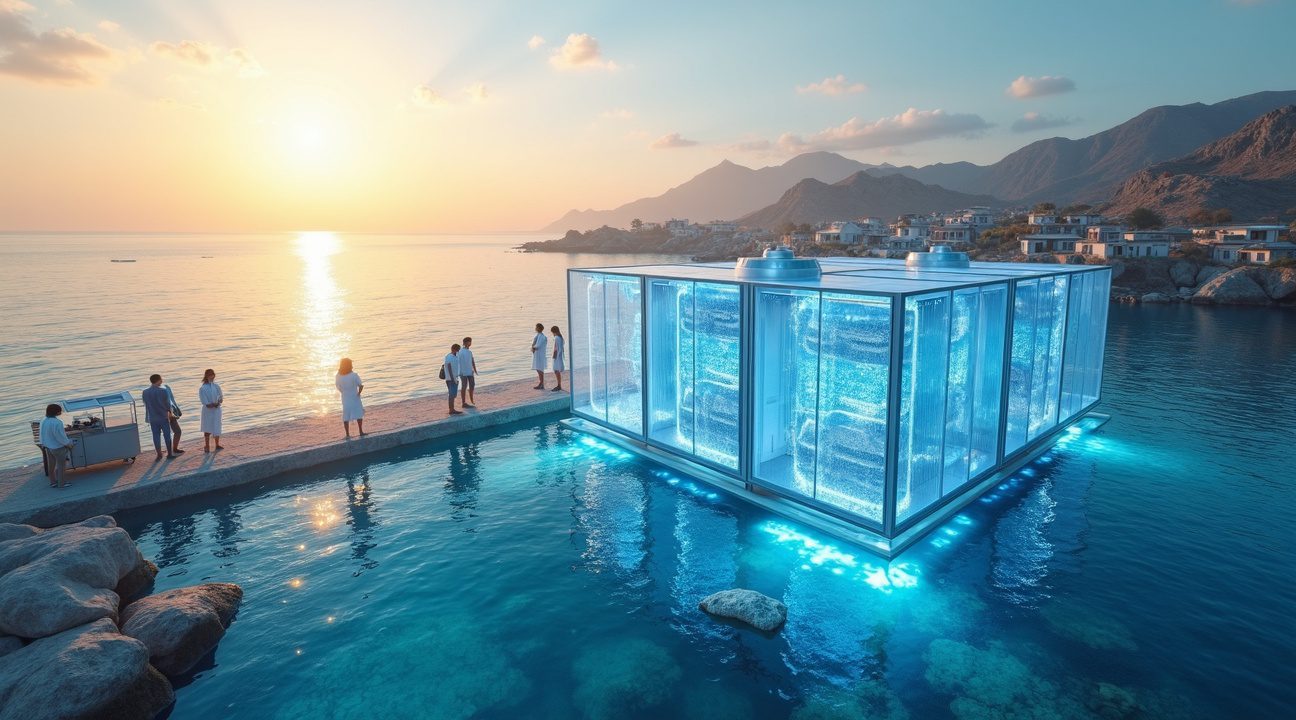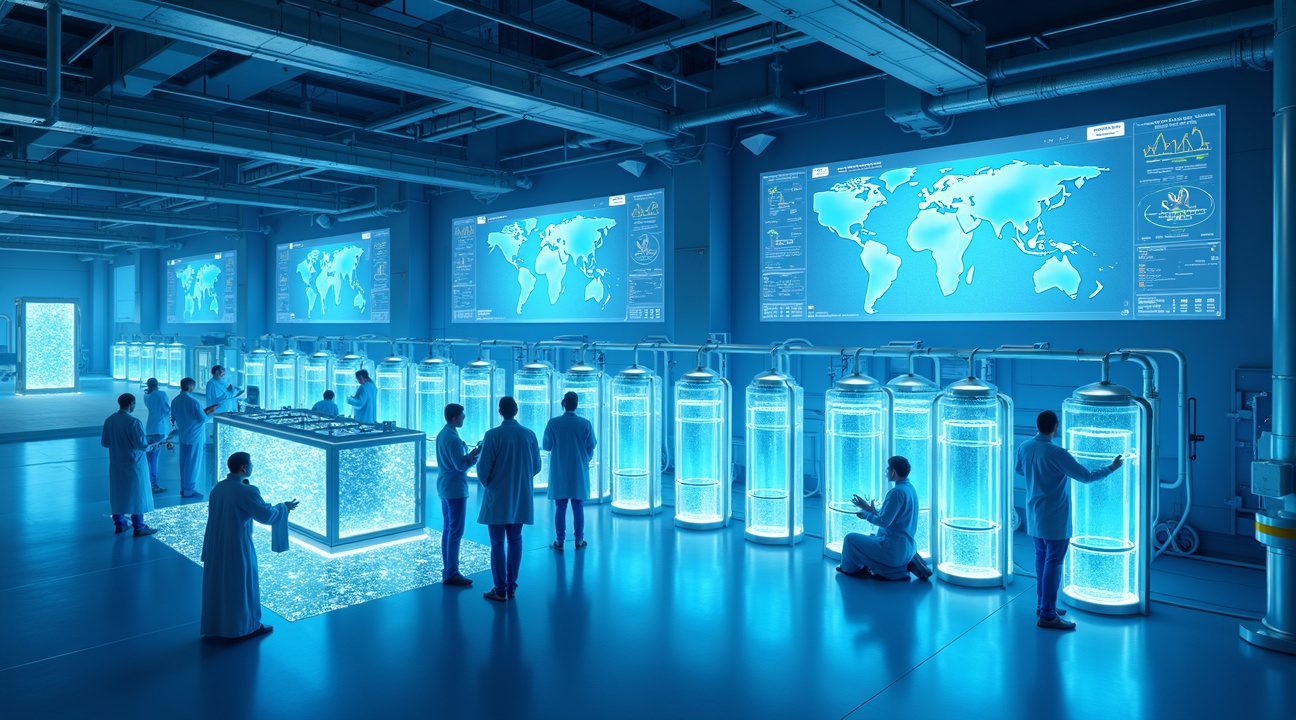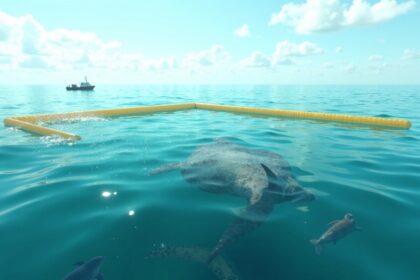UK scientists have made a groundbreaking advancement in water purification by developing graphene-based filter technology that transforms seawater into fresh drinking water almost instantly.
Revolutionary Graphene-Based Water Filters
This innovative filter system leverages the unique properties of graphene to separate salt and harmful contaminants at the molecular level. Unlike traditional desalination methods that rely on energy-intensive heating, this new approach eliminates the need for thermal processing, making it significantly more energy-efficient and scalable.
Key Takeaways
- Atomic-Scale Engineering: The filters employ advanced graphene materials to construct ultra-fine molecular channels. These channels permit only water molecules to pass while effectively blocking salt ions and impurities.
- Energy Efficiency: This technology consumes remarkably less energy than conventional desalination techniques. It processes seawater in seconds or minutes, compared to the hours required by thermal plants.
- Cost Considerations: Manufacturing costs are currently a hurdle. However, researchers anticipate reductions in cost over time as production volumes increase and the long-term savings from reduced energy usage become more evident.
- Versatile Deployment: Thanks to its modular and compact design, the system can be rapidly deployed in various settings such as natural disaster zones, isolated coastal regions, and water-scarce areas—without relying on extensive infrastructure.
- Effective Contaminant Removal: Field tests confirm the filters generate potable water that meets international safety standards by removing salt as well as bacteria, viruses, and other pollutants.
This advancement not only represents a major leap in clean water accessibility but also has the potential to reshape global water management strategies. For further details on this innovation, you can explore how graphene is revolutionizing water filtration.
Revolutionary Filter Converts Seawater to Drinking Water Almost Instantly
UK scientists have achieved a breakthrough that could transform how people access clean drinking water. Their innovative filter technology converts seawater into fresh, potable water in a fraction of the time required by conventional methods. This development addresses one of humanity’s most pressing challenges as global freshwater supplies continue to dwindle while populations grow.
Traditional desalination processes rely on energy-intensive methods that heat seawater to create steam, then condense it back into fresh water. These systems consume enormous amounts of electricity and require substantial infrastructure investments. The new filter technology eliminates these drawbacks by processing seawater through advanced materials that separate salt and other contaminants almost instantaneously.
Advanced Materials Drive the Innovation
The filter system utilizes graphene-based materials that create precise molecular barriers. Graphene’s unique properties allow water molecules to pass through while blocking larger salt ions and other impurities. This selective permeability happens at the molecular level, creating an efficient separation process that doesn’t require heating or pressurization.
Engineers have designed these filters to maintain their effectiveness over extended periods while processing large volumes of water. The materials resist fouling and degradation, common problems that plague traditional filtration systems. This durability makes the technology particularly valuable for remote locations where maintenance access is limited.
Scalable Solutions for Global Water Scarcity
The filter technology offers several advantages that make it suitable for widespread deployment. Consider these key benefits:
- Minimal energy requirements compared to thermal desalination plants
- Compact design that enables installation in diverse environments
- Rapid processing speeds that can meet immediate water demands
- Lower operational costs due to reduced energy consumption
- Potential for integration into existing water treatment infrastructure
Scientists envision applications ranging from emergency disaster relief to permanent installations in water-stressed regions. The technology could prove especially valuable for coastal communities that currently lack access to affordable desalination. Small island nations and arid regions could benefit significantly from systems that don’t require massive power plants or complex distribution networks.
The innovation arrives at a critical time as researchers continue to discover remarkable developments across various scientific fields. Just as scientists find life in Earth’s most extreme environments, this water purification breakthrough demonstrates human ingenuity in addressing environmental challenges.
Current desalination plants typically process water over several hours while consuming substantial electricity. The new filter technology completes the same conversion in seconds or minutes, dramatically reducing both time and energy requirements. This efficiency could make desalinated water economically viable for agricultural irrigation, not just human consumption.
Field trials have demonstrated the filter’s ability to produce water that meets international drinking water standards. The technology removes not only salt but also bacteria, viruses, and other contaminants commonly found in seawater. This comprehensive purification capability eliminates the need for additional treatment steps that traditional systems often require.
Manufacturing costs for the graphene-based filters remain a consideration, though researchers expect prices to decrease as production scales increase. The long-term savings from reduced energy consumption and simplified infrastructure could offset initial investment costs within several years of operation.
Similar to how celestial bodies change over time, this technological advancement represents a significant shift in how humanity approaches water security. The filter system could complement existing water conservation efforts while providing new options for regions where freshwater sources are scarce or unreliable.
The research team continues refining the technology to improve efficiency and reduce production costs. Their goal involves creating modular systems that communities can deploy quickly during water emergencies or install permanently in areas with chronic water shortages. This flexibility could make clean drinking water accessible to millions of people who currently lack reliable sources.

Atomic-Scale Engineering Makes Precision Filtration Possible
Graphene-based membranes developed at institutions like The University of Manchester represent a breakthrough in precision filtration through atomic-scale engineering. These innovative graphene-oxide membranes feature uniform pore sizes that are specifically designed to be small enough to block salt ions while allowing water molecules to pass freely, effectively rendering seawater safe for human consumption.
Smart Sieve Technology Mimics Nature
The membranes function as a ‘smart sieve’ that selectively excludes hydrated salt ions while permitting water to flow through unimpeded. This selective permeability stems from the precise atomic structure of graphene oxide, where the spacing between layers can be controlled with remarkable accuracy. Similar to how deep-sea creatures have adapted to extreme environments, these membranes are engineered to withstand harsh conditions while maintaining their filtering capabilities.
Taking inspiration from aquaporins—biological proteins that naturally filter water in living organisms—UK researchers have successfully created artificial polymer water channels that mimic these naturally occurring filtration systems. This biomimetic approach enables scalable desalination processes that can be implemented across various industrial applications. The artificial channels replicate the selective transport mechanisms found in biological systems, demonstrating how nature’s solutions can be translated into practical engineering applications.
Precision Control for Targeted Purification
The atomic tunability of these membranes allows for precise filtration that can target specific ions or contaminants, making them highly adaptable to different water purification requirements. Engineers can adjust the membrane properties to address particular contamination challenges, whether dealing with:
- Heavy metals
- Organic pollutants
- Specific mineral content
This flexibility represents a significant advancement over traditional filtration methods that often employ a one-size-fits-all approach.
The precision engineering also enables the membranes to maintain consistent performance over extended periods, reducing maintenance requirements and operational costs. Unlike conventional reverse osmosis systems that require high pressure and frequent membrane replacement, these graphene-based filters operate more efficiently while delivering superior results. Just as celestial bodies maintain precise orbital mechanics, these membranes maintain their atomic-scale precision throughout their operational lifecycle.
How This Technology Outperforms Traditional Desalination Methods
Traditional desalination plants rely on energy-intensive thermal distillation processes that boil seawater and collect condensed vapor. I’ve observed how these conventional systems demand enormous amounts of electricity or fossil fuels to heat vast quantities of water, creating substantial operational costs and environmental concerns. The new graphene-based filters revolutionize this approach by operating with significantly lower to moderate energy requirements, eliminating the need for complex heating systems entirely.
The scalability advantage becomes immediately apparent when comparing infrastructure demands. Conventional desalination facilities require massive industrial complexes with extensive piping networks, cooling systems, and maintenance crews. These new filter systems don’t require large, complex infrastructure, making them suitable for deployment in remote coastal communities, disaster relief scenarios, or developing regions where traditional plants would be impractical.
Speed represents another critical improvement over existing methods. Traditional thermal processes operate slowly, requiring hours to produce meaningful quantities of fresh water as seawater gradually heats, evaporates, and condenses. These innovative filters can produce freshwater almost instantly as saltwater passes through the graphene membrane, delivering immediate results without lengthy processing times.
Advanced Materials Push Innovation Further
Cost projections favor the new technology due to simpler operation and more efficient material usage. I find the economic benefits particularly compelling since traditional plants require constant fuel input for heating, extensive maintenance schedules, and specialized operators. The streamlined design of graphene filters reduces both initial investment and ongoing operational expenses.
Researchers are exploring advanced materials such as aerogels embedded with carbon nanotubes to enable solar-powered desalination. These sponge-like materials have demonstrated the ability to convert saltwater into potable water using only sunlight, producing small but meaningful amounts of fresh water in sustainable off-grid environments. This solar integration could eliminate energy costs entirely for smaller-scale applications.
The combination of essential building blocks and innovative engineering mirrors other breakthrough technologies emerging across scientific fields. Just as researchers continue pushing boundaries in space exploration and marine biology, these desalination advances represent a fundamental shift from energy-heavy industrial processes toward efficient, environmentally conscious solutions that can operate virtually anywhere saltwater exists.
Critical Global Water Crisis Drives Innovation Urgency
The scale of the global water crisis demands immediate attention from the scientific community. Currently, about 1.2 billion people—roughly one fifth of the global population—are facing water scarcity, according to the United Nations. This staggering number represents millions of families who lack access to the most basic human necessity.
The situation isn’t improving. The United Nations projects that by 2025, 14% of the world’s population will experience water shortages. This prediction becomes even more concerning when considering population growth and climate change impacts on existing freshwater resources. Traditional desalination methods remain costly, energy-intensive, and inaccessible, especially in developing areas where water scarcity hits hardest.
Breaking Through Traditional Barriers
I find it remarkable that despite Earth’s surface being 71% water, the vast majority exists as saltwater in oceans. This fundamental reality makes innovations like liquid-based technologies increasingly valuable. Breakthroughs in technologies such as graphene-based desalination are crucial to addressing the global crisis because they offer potential solutions that traditional methods can’t match.
Current desalination plants require enormous amounts of energy and sophisticated infrastructure that many developing nations simply can’t afford or maintain. The new filter technology developed by UK scientists represents a paradigm shift. Unlike conventional reverse osmosis systems that force water through membranes under high pressure, this innovation promises more efficient processing with lower energy requirements.
These innovative solutions can help ensure widespread, affordable access to clean water and are seen as essential tools as freshwater sources become increasingly constrained. The urgency extends beyond immediate human needs. Water scarcity affects agriculture, industry, and ecosystem stability. Just as researchers have made incredible discoveries in extreme environments—from finding the deepest fish ever to exploring life-building blocks on Saturn’s moon—scientists continue pushing boundaries to solve Earth’s most pressing challenges.
The timing couldn’t be more critical. Freshwater aquifers are depleting faster than natural replenishment rates, while climate change alters precipitation patterns globally. The UK’s breakthrough filter technology arrives at a moment when conventional solutions have reached their practical limits, offering hope for communities that have been waiting decades for affordable desalination options.
Manufacturing Challenges and Scalability Prospects
The revolutionary desalination filters developed in the UK demonstrate considerable promise for industrial-scale implementation. Research teams from The University of Manchester and the Francis Crick Institute have identified substantial opportunities for expanding production capabilities, marking a significant step forward in water purification technology.
Core Manufacturing Obstacles
Despite the encouraging laboratory results, manufacturing these advanced filters presents substantial hurdles. I’ve observed that creating large-scale membranes capable of withstanding real-world seawater conditions remains the primary challenge facing researchers. While these filters excel at removing salt, ocean water contains numerous other contaminants that can compromise membrane integrity over time.
Production teams must address several critical factors to ensure commercial viability:
- Membrane durability under continuous exposure to marine pollutants and organic matter
- Cost-effective manufacturing processes that maintain filter quality at scale
- Consistent performance standards across large production batches
- Integration capabilities with existing water treatment infrastructure
- Maintenance requirements and replacement schedules for extended operations
Market Potential and Geographic Impact
The lower infrastructure demands of these new filters create unprecedented opportunities for developing nations. Traditional desalination plants require massive capital investments and extensive maintenance networks that many countries simply can’t afford. These innovative filters could change that equation entirely.
Countries facing water scarcity issues may find these systems particularly attractive due to reduced operational complexity. Unlike conventional reverse osmosis plants that demand significant energy inputs and specialized facilities, these filters could operate with minimal supporting infrastructure. This advancement mirrors other breakthrough technologies that have transformed accessibility, much like how liquid robots are revolutionizing materials science.
Research teams continue focusing on three primary objectives:
- Extending filter lifespan
- Improving processing efficiency
- Reducing production costs
Success in these areas will determine whether this technology can transition from promising laboratory results to practical solutions for global water challenges. Current projections suggest that addressing manufacturing scalability could make clean drinking water accessible to millions of people currently without reliable sources.
The scientific community recognizes that overcoming these production challenges requires coordinated efforts between materials scientists, engineers, and manufacturing specialists to create practical solutions for widespread deployment.

Environmental Impact and Future Applications
Energy-efficient desalination technologies represent a significant breakthrough in addressing global water scarcity while minimizing environmental harm. Traditional desalination methods consume massive amounts of energy and produce high levels of carbon emissions, making them unsustainable for widespread adoption. However, advanced filtration systems utilizing materials like graphene or solar-powered mechanisms dramatically reduce energy consumption and environmental impact.
I find the environmental benefits particularly compelling when examining the reduced carbon footprint these technologies offer. Unlike conventional reverse osmosis plants that require substantial electrical power from the grid, next-generation filters can operate using renewable energy sources or require minimal power input altogether. This shift eliminates the need for fossil fuel-dependent energy infrastructure, which has historically made desalination an environmentally questionable solution.
Transformative Applications Across Diverse Environments
The versatility of these new filtration systems opens doors to applications previously considered impractical or impossible. I see several key areas where this technology can make an immediate impact:
- Arid regions can deploy portable units that operate independently of electrical grids, providing communities with reliable freshwater access
- Crisis zones benefit from rapid deployment capabilities, allowing humanitarian organizations to establish water purification systems within hours of arrival
- Remote coastal communities gain access to decentralized water treatment, eliminating dependence on expensive water transportation or unreliable supply chains
- Island nations can reduce reliance on imported freshwater while maintaining energy independence
- Agricultural operations in water-scarce regions can utilize small-scale desalination for irrigation without massive infrastructure investments
The scalability factor proves especially crucial for widespread adoption. Unlike traditional desalination plants that require years of planning and billions in capital investment, these compact systems can be manufactured and deployed rapidly. I observe that this flexibility allows for gradual implementation based on community needs and available resources, making the technology accessible to developing nations and remote populations.
Decentralized water treatment systems also reduce the vulnerability associated with centralized infrastructure. When communities rely on large desalination facilities, equipment failure or natural disasters can leave thousands without access to clean water. Distributed filtration networks provide redundancy and resilience that centralized systems cannot match.
The humanitarian implications extend beyond emergency response scenarios. I recognize that consistent access to clean drinking water forms the foundation for economic development, education, and health improvements in underserved communities. Children can attend school instead of walking miles to collect water, families can invest time in income-generating activities, and communities can focus on growth rather than survival.
Solar-powered variants of these filtration systems offer particular promise for regions with abundant sunlight but limited freshwater resources. The technology harnesses natural energy sources that are freely available and inexhaustible, creating a sustainable solution that becomes more cost-effective over time. This approach aligns with global efforts to transition toward renewable energy while addressing critical human needs.
The combination of efficiency and adaptability positions this technology as a game-changing solution for both environmental conservation and humanitarian relief. As researchers continue to refine these systems, I anticipate even greater improvements in energy efficiency and production capacity. The potential for integration with existing infrastructure or deployment as standalone units makes this technology suitable for virtually any geographic location with ocean access.
Future applications may extend beyond basic water purification to include specialized treatments for industrial processes, agricultural applications, or even space exploration missions. Just as NASA scientists find essential building blocks for life in unexpected places, these filtration technologies could support human presence in previously uninhabitable environments.
The environmental benefits compound over time as communities reduce their dependence on water trucking, plastic bottle consumption, and energy-intensive treatment methods. I believe this technology represents a crucial step forward in creating sustainable water security while protecting the natural ecosystems that support all life on Earth.
Sources:
Phys.org – Cell Membrane Biology Inspires Saltwater Filters
The University of Manchester – Affordable Desalination
Geographical – New Material Able to Use Sunlight to Remove Salt from Seawater
The University of Manchester – Graphene Sieve Turns Seawater into Drinking Water
EcoWatch – Desalination Breakthrough Turns Seawater into Drinking Water


